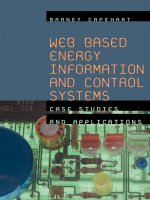Decision support and BI systems ch12
Bạn đang xem bản rút gọn của tài liệu. Xem và tải ngay bản đầy đủ của tài liệu tại đây (4.73 MB, 59 trang )
Decision Support and
Business Intelligence
Systems
(9th Ed., Prentice Hall)
Chapter 12:
Artificial Intelligence and
Expert Systems
Learning Objectives
12-2
Understand the basic concepts and definitions
of artificial intelligence (AI)
Become familiar with the AI field and its
evolution
Understand and appreciate the importance of
knowledge in decision support
Become accounted with the concepts and
evolution of rule-based expert systems (ES)
Understand the general architecture of rulebased expert systems
Learn the knowledge engineering process, a
systematic way to build ES
Copyright © 2011 Pearson Education, Inc. Publishing as Prentice Hall
Learning Objectives
12-3
Learn the benefits, limitations and critical
success factors of rule-based expert systems
for decision support
Become familiar with proper applications of ES
Learn the synergy between Web and rule-based
expert systems within the context of DSS
Learn about tools and technologies for
developing rule-based DSS
Develop familiarity with an expert system
development environment via hands-on
exercises
Copyright © 2011 Pearson Education, Inc. Publishing as Prentice Hall
Opening Vignette:
“A Web-based Expert System for Wine Selection”
12-4
Company background
Problem description
Proposed solution
Results
Answer and discuss the case questions
Copyright © 2011 Pearson Education, Inc. Publishing as Prentice Hall
Artificial Intelligence (AI)
Artificial intelligence (AI)
AI has many definitions…
12-5
A subfield of computer science, concerned
with symbolic reasoning and problem solving
Behavior by a machine that, if performed by a
human being, would be considered intelligent
“…study of how to make computers do things
at which, at the moment, people are better
Theory of how the human mind works
Copyright © 2011 Pearson Education, Inc. Publishing as Prentice Hall
AI Objectives
Make machines smarter (primary goal)
Understand what intelligence is
Make machines more intelligent and useful
Signs of intelligence…
12-6
Learn or understand from experience
Make sense out of ambiguous situations
Respond quickly to new situations
Use reasoning to solve problems
Apply knowledge to manipulate the
environment
Copyright © 2011 Pearson Education, Inc. Publishing as Prentice Hall
Test for Intelligence
Turing Test for
Intelligence
A computer can be
considered to be smart
only when a human
interviewer,
“conversing” with both
an unseen human
being and an unseen
computer, can not
determine which is
which.
- Alan Turing
12-7
Copyright © 2011 Pearson Education, Inc. Publishing as Prentice Hall
Symbolic Processing
AI …
represents knowledge as a set of symbols, and
uses these symbols to represent problems, and
apply various strategies and rules to manipulate
symbols to solve problems
A symbol is a string of characters that stands for
some real-world concept (e.g., Product, consumer,
…)
Examples:
(DEFECTIVE product)
(LEASED-BY product customer) - LISP
Tastes_Good (chocolate)
12-8
Copyright © 2011 Pearson Education, Inc. Publishing as Prentice Hall
AI Concepts
Reasoning
Pattern Matching
Inferencing from facts and rules using heuristics or
other search approaches
Attempt to describe and match objects, events, or
processes in terms of their qualitative features and
logical and computational relationships
Knowledge Base
Computer
INPUTS
(questions,
problems, etc.)
12-9
Knowledge
Base
Inference
Capability
Copyright © 2011 Pearson Education, Inc. Publishing as Prentice Hall
OUTPUTS
(answers,
alternatives, etc.)
Evolution of artificial intelligence
12-10
Copyright © 2011 Pearson Education, Inc. Publishing as Prentice Hall
Artificial vs. Natural Intelligence
Advantages of AI
Advantages of Biological Natural Intelligence
12-11
More permanent
Ease of duplication and dissemination
Less expensive
Consistent and thorough
Can be documented
Can execute certain tasks much faster
Can perform certain tasks better than many
people
Is truly creative
Can use sensory input directly and creatively
Can apply experience in different situations
Copyright © 2011 Pearson Education, Inc. Publishing as Prentice Hall
The AI Field
AI is many different sciences and
technologies
It is a collection of concepts and ideas
Chemistry
12-12
Linguistics
Psychology
Philosophy
Computer Science
Electrical Engineering
Mechanics
Hydraulics
Physics
Optics
Management and
Organization Theory
Chemistry
Physics
Statistics
Mathematics
Management Science
Management Information
Systems
Computer hardware and
software
Commercial, Government and
Military Organizations
…
Copyright © 2011 Pearson Education, Inc. Publishing as Prentice Hall
The AI Field…
12-13
AI provides the
scientific
foundation for
many
commercial
technologies
Copyright © 2011 Pearson Education, Inc. Publishing as Prentice Hall
AI Areas
Major…
Additional…
12-14
Expert Systems
Natural Language Processing
Speech Understanding
Robotics and Sensory Systems
Computer Vision and Scene Recognition
Intelligent Computer-Aided Instruction
Automated Programming
Neural Computing Game Playing
Game Playing, Language Translation
Fuzzy Logic, Genetic Algorithms
Intelligent Software Agents
Copyright © 2011 Pearson Education, Inc. Publishing as Prentice Hall
AI is often transparent in many
commercial products
Anti-lock Braking Systems (ABS)
Automatic Transmissions
Video Camcorders
Appliances
12-15
Washers, Toasters, Stoves
Help Desk Software
Subway Control…
Copyright © 2011 Pearson Education, Inc. Publishing as Prentice Hall
Expert Systems (ES)
Is a computer program that attempts to
imitate expert’s reasoning processes and
knowledge in solving specific problems
Most Popular Applied AI Technology
Works best with narrow problem areas/tasks
Expert systems do not replace experts, but
12-16
Enhance Productivity
Augment Work Forces
Make their knowledge and experience more
widely available, and thus
Permit non-experts to work better
Copyright © 2011 Pearson Education, Inc. Publishing as Prentice Hall
Important Concepts in ES
Expert
A human being who has developed a high level of
proficiency in making judgments in a specific
domain
Expertise
The set of capabilities that underlines the
performance of human experts, including
12-17
extensive domain knowledge,
heuristic rules that simplify and improve approaches to
problem solving,
meta-knowledge and meta-cognition, and
compiled forms of behavior that afford great economy
in a skilled performance
Copyright © 2011 Pearson Education, Inc. Publishing as Prentice Hall
Important Concepts in ES
Experts
Transferring Expertise
12-18
From expert to computer to nonexperts via
acquisition, representation, inferencing, transfer
Inferencing
Degrees or levels of expertise
Nonexperts outnumber experts often by 100 to
1
Knowledge = Facts + Procedures (Rules)
Reasoning/thinking performed by a computer
Rules (IF … THEN …)
Explanation Capability (Why? How?)
Copyright © 2011 Pearson Education, Inc. Publishing as Prentice Hall
Applications of Expert Systems
DENDRAL
MYCIN
A rule-based expert system
Used for diagnosing and treating bacterial
infections
XCON
Applied knowledge (i.e., rule-based reasoning)
Deduced likely molecular structure of compounds
A rule-based expert system
Used to determine the optimal information
systems configuration
New applications: Credit analysis, Marketing,
Finance, Manufacturing, Human resources,
Science and Engineering, Education, …
12-19
Copyright © 2011 Pearson Education, Inc. Publishing as Prentice Hall
Structures of
Expert Systems
1.
2.
Development
Environment
Consultation
(Runtime)
Environment
12-20
Copyright © 2011 Pearson Education, Inc. Publishing as Prentice Hall
Conceptual Architecture of a
Typical Expert Systems
12-21
Copyright © 2011 Pearson Education, Inc. Publishing as Prentice Hall
The Human Element in ES
Expert
Knowledge Engineer
Helps the expert(s) structure the problem area
by interpreting and integrating human answers
to questions, drawing analogies, posing
counter examples, and enlightening conceptual
difficulties
User
Others
12-22
Has the special knowledge, judgment,
experience and methods to give advice and
solve problems
System Analyst, Builder, Support Staff, …
Copyright © 2011 Pearson Education, Inc. Publishing as Prentice Hall
Structure of ES
Three major components in ES are:
ES may also contain:
12-23
Knowledge base
Inference engine
User interface
Knowledge acquisition subsystem
Blackboard (workplace)
Explanation subsystem (justifier)
Knowledge refining system
Copyright © 2011 Pearson Education, Inc. Publishing as Prentice Hall
Structure of ES
12-24
Knowledge acquisition (KA)
The extraction and formulation of knowledge derived
from various sources, especially from experts (elicitation)
Knowledge base
A collection of facts, rules, and procedures organized into
schemas. The assembly of all the information and
knowledge about a specific field of interest
Blackboard (working memory)
An area of working memory set aside for the description
of a current problem and for recording intermediate
results in an expert system
Explanation subsystem (justifier)
The component of an expert system that can explain the
system’s reasoning and justify its conclusions
Copyright © 2011 Pearson Education, Inc. Publishing as Prentice Hall
Knowledge Engineering (KE)
A set of intensive activities encompassing
the acquisition of knowledge from human
experts (and other information sources)
and converting this knowledge into a
repository (commonly called a knowledge
base)
The primary goal of KE is
12-25
to help experts articulate how they do what
they do, and
to document this knowledge in a reusable form
Narrow versus Broad definition of KE?
Copyright © 2011 Pearson Education, Inc. Publishing as Prentice Hall









